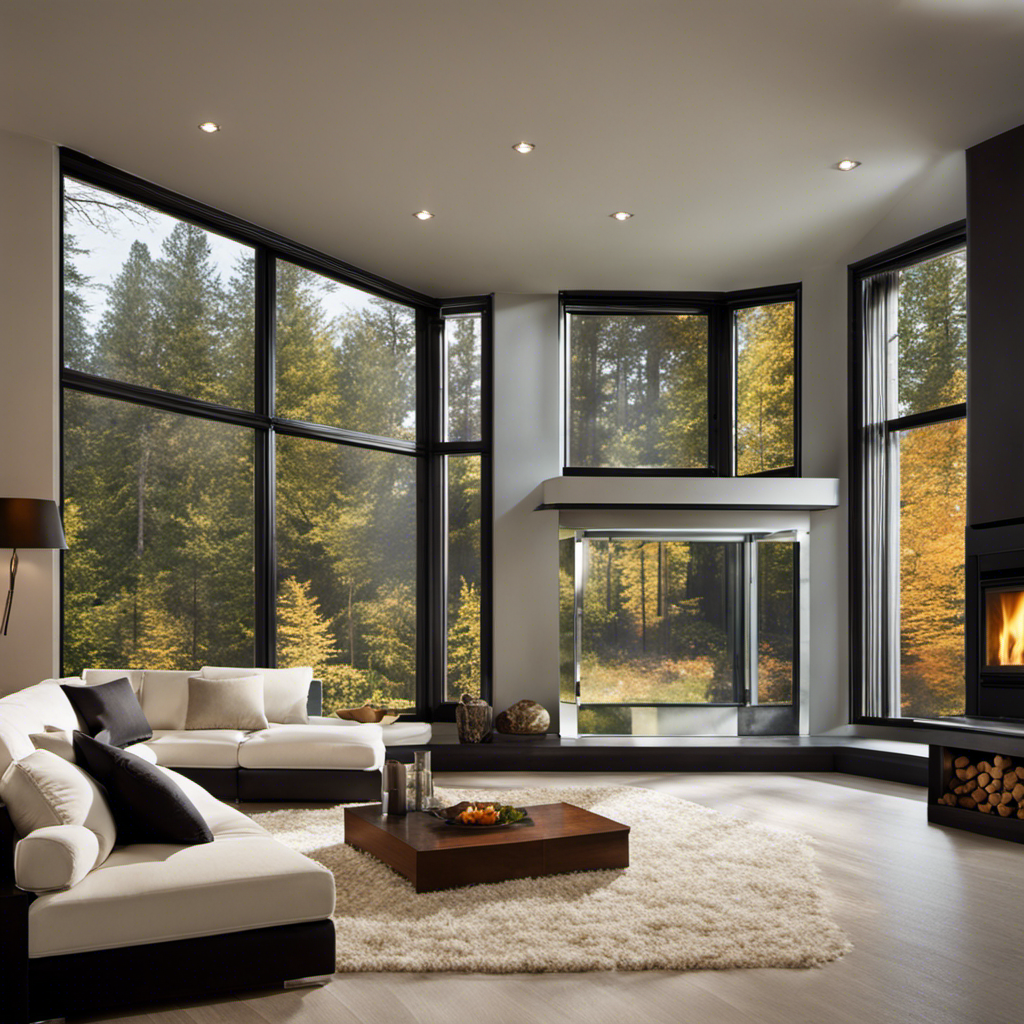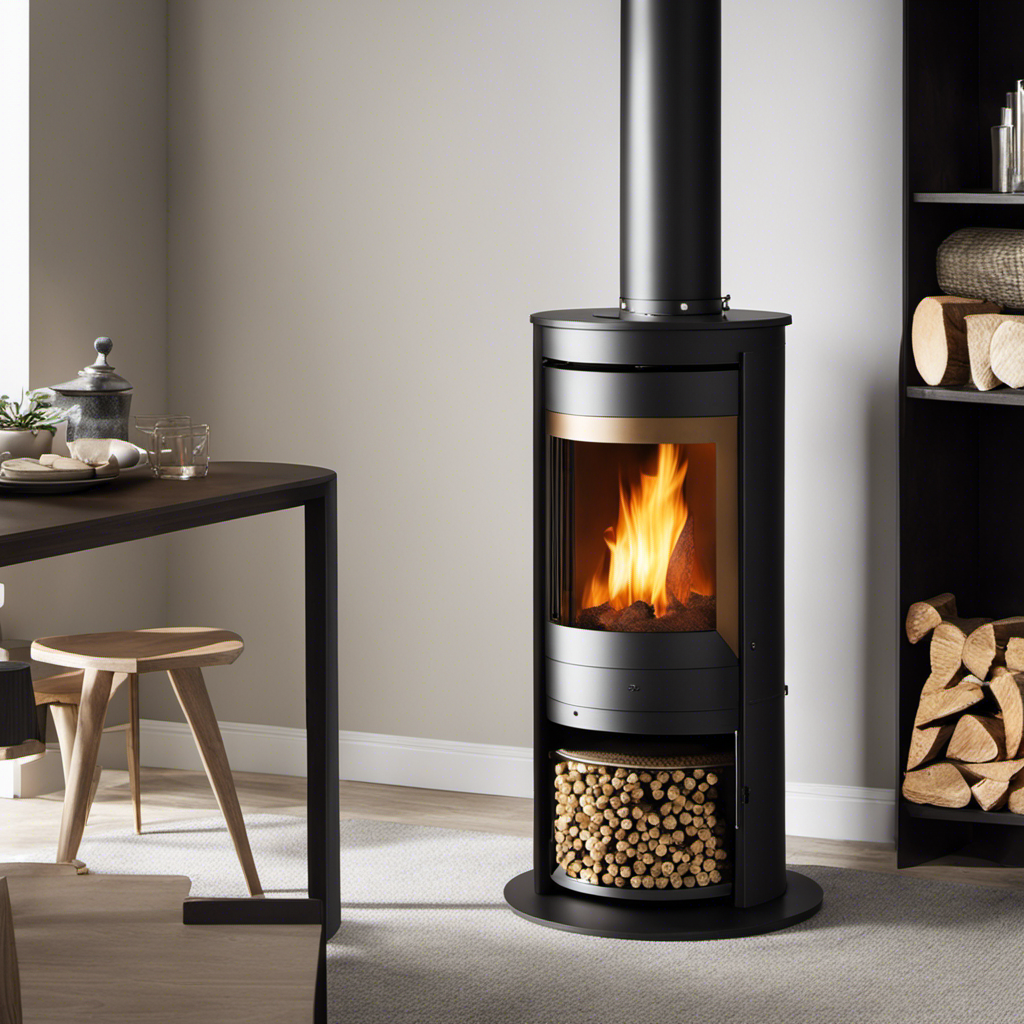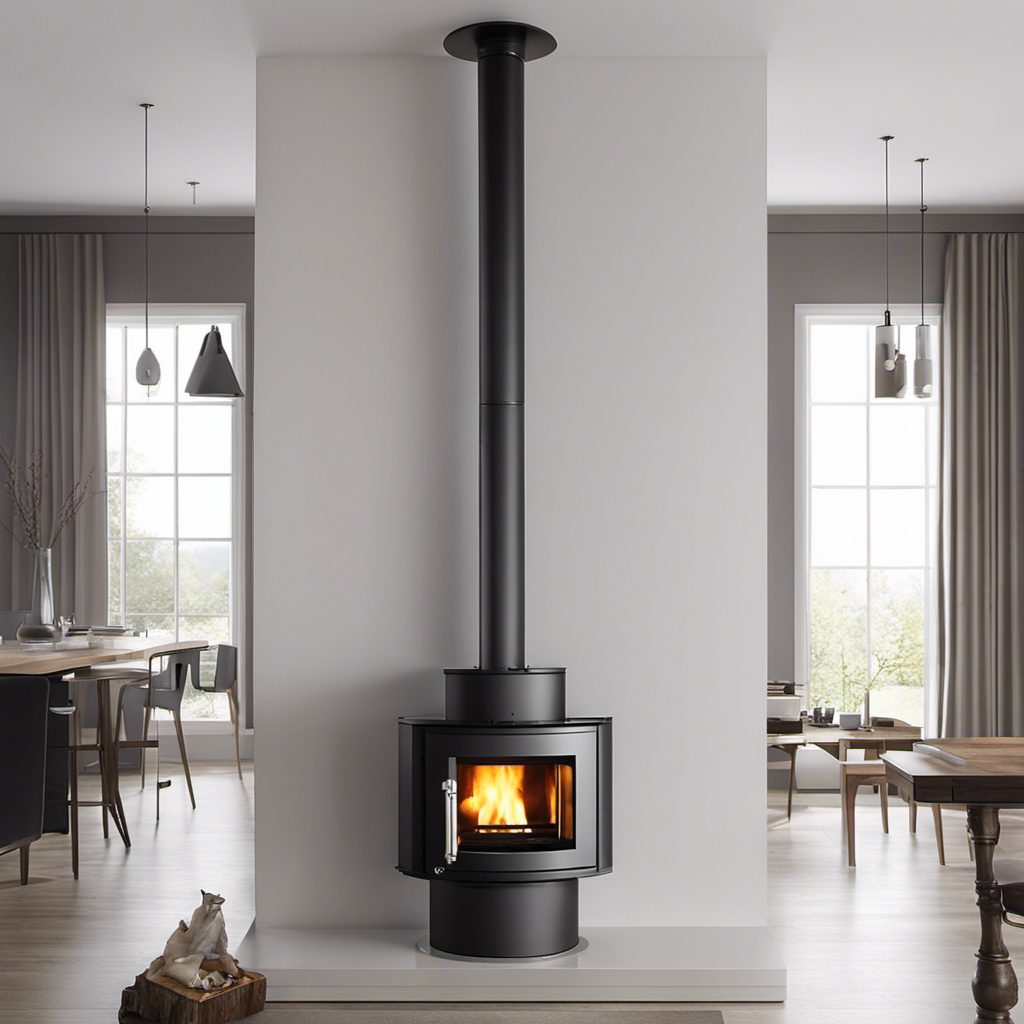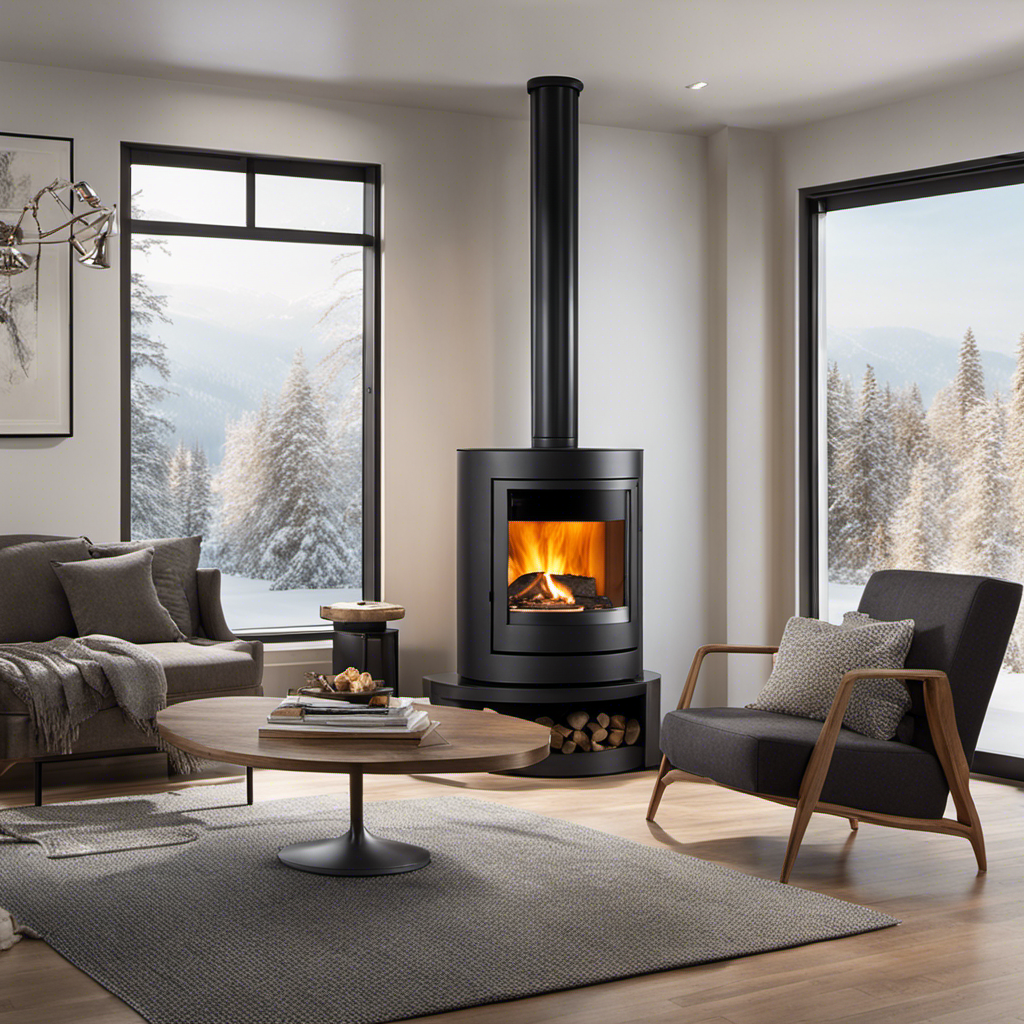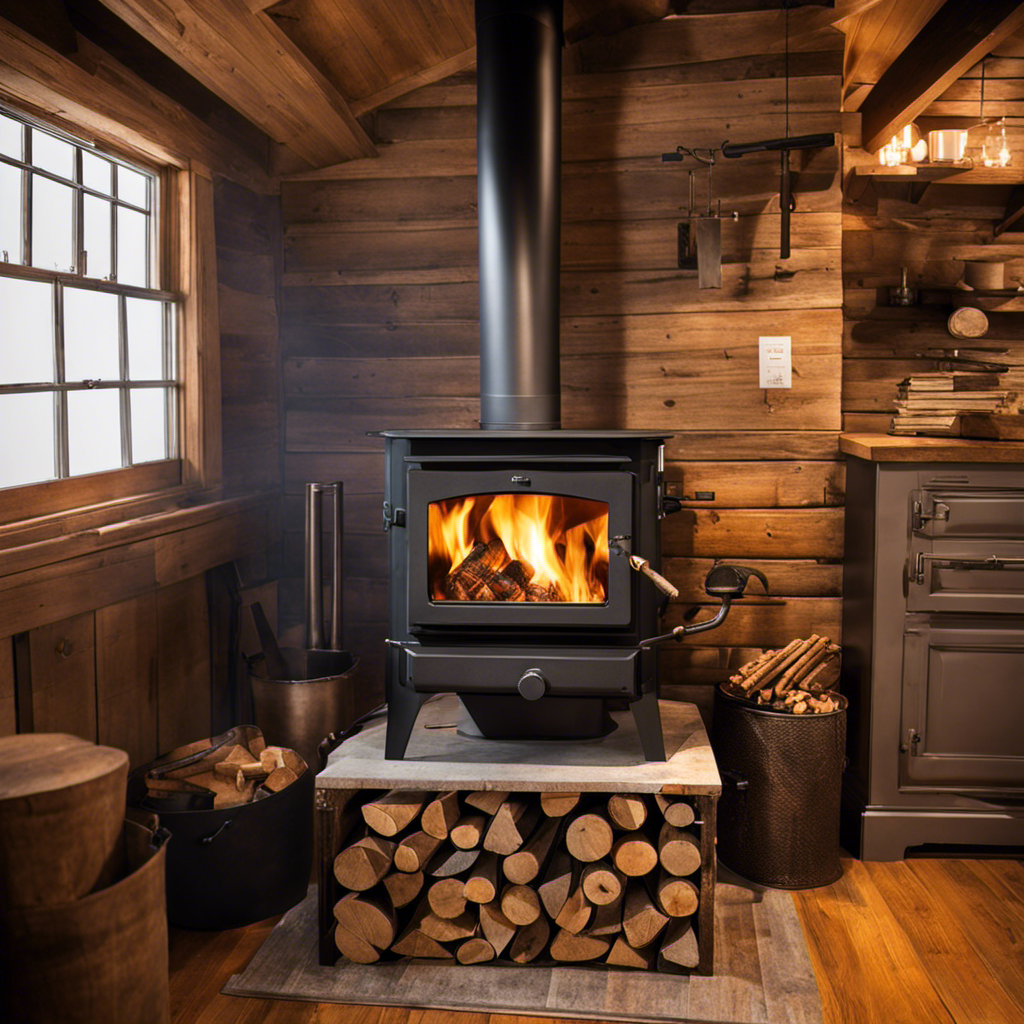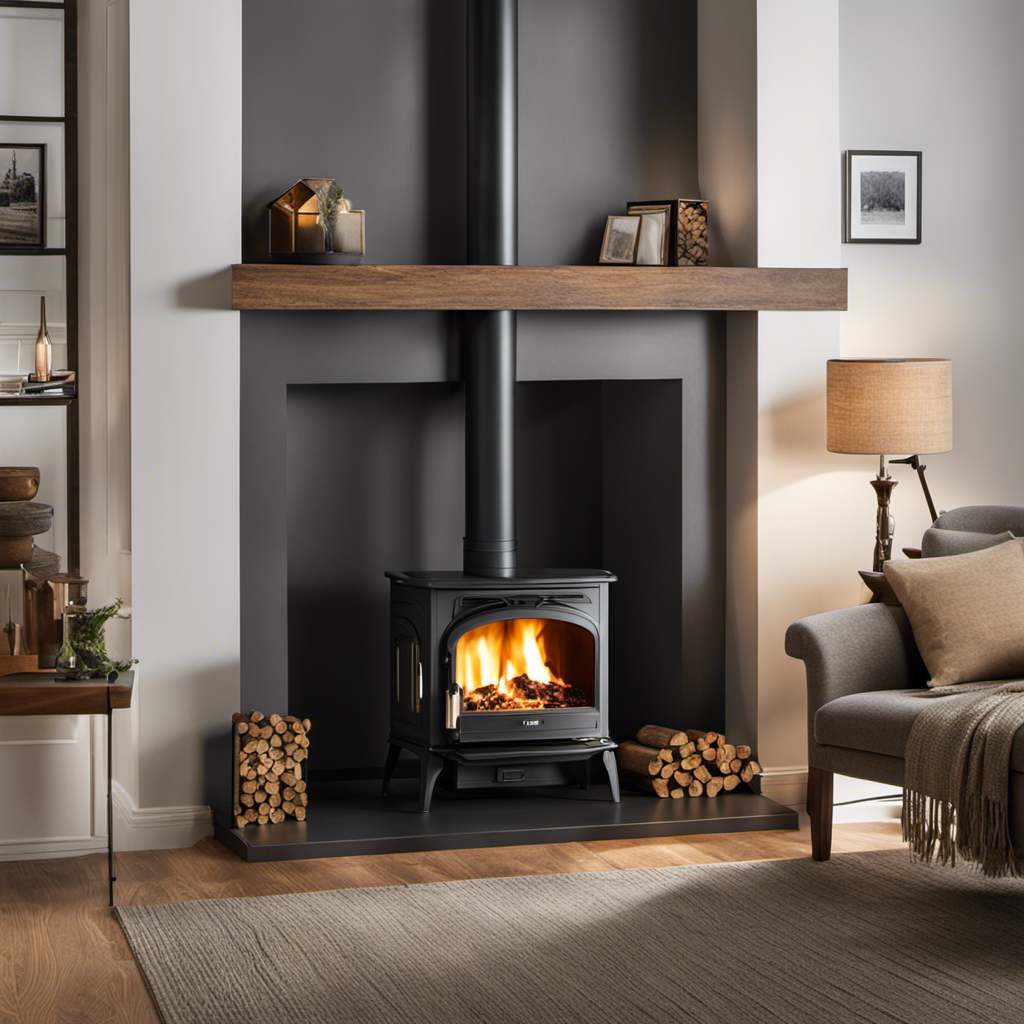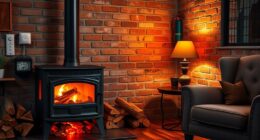Fed up with constantly needing to clean the glass on your pellet stove? Great news, we have the ideal solution for you!
In this article, we’re going to share with you our expert tips and tricks on how to master the art of keeping your pellet stove glass spotless. Say goodbye to blackened glass and hello to a clean, clear view of your fire.
Get ready to take your pellet stove game to the next level!
Key Takeaways
- Using high-quality pellets made from pure wood with low moisture content helps prevent soot and creosote buildup on pellet stove glass.
- Regularly cleaning the glass with a soft cloth and stove cleaning agent keeps it free from baked-on dirt and grime.
- Maintaining the correct air supply and cleaning the air supply system ensures efficient burning and prevents soot and creosote on the glass.
- Checking for leaks in the exhaust system and promptly repairing them helps maintain stove efficiency and prevents dirty glass.
Causes of Blackened Glass on Pellet Stove
Understanding these causes helps us prevent blackened glass on our pellet stove. One of the main causes is low-quality fuel with impurities. When we burn such fuel, it leads to the accumulation of creosote and soot on the glass. To prevent this, it’s important to use high-quality pellets made from pure wood with low moisture content.
Another cause of blackened glass is incorrect burning temperature. If the temperature is too low, it can result in incomplete combustion and dirty glass. Regular cleaning of the glass is essential to prevent soot and creosote buildup. We can use soft cloths and specialized cleaning agents designed for stove glass to keep it clean.
Taking these preventive measures will ensure that our pellet stove glass remains clear and free from blackened residue.
Low-Quality Fuel and Its Impact on Glass
Using low-quality fuel with impurities leads to creosote and soot buildup, which affects the cleanliness of our pellet stove glass. These impurities can have a significant impact on the efficiency of our stove as well.
To avoid these issues, it’s important to consider low-quality fuel alternatives that are cleaner and more efficient. By using high-quality pellets made from pure wood with low moisture content, we can minimize the presence of impurities and reduce the buildup on the glass.
Additionally, maintaining the correct air supply to prevent soot and creosote buildup is crucial. Regular cleaning of the air supply system and checking for leaks in the exhaust system are also important steps in keeping our stove efficient and our glass clean.
Incorrect Burning Temperature and Glass Staining
When the burning temperature is incorrect, it can result in staining on our pellet stove glass. The impact of creosote on the glass is significant, as it’s a byproduct of burning fuel and can accumulate on the glass surface, causing it to blacken. To prevent this, it’s important to control the burning temperature.
Here are some tips to keep in mind:
- Adjust the air supply to maintain the correct burning temperature.
- Avoid burning low-quality fuel that produces more creosote.
- Regularly clean the glass to remove any creosote buildup.
- Use high-quality pellets with low moisture content to minimize creosote formation.
- Schedule regular maintenance to ensure the exhaust system is clean and functioning properly.
Clogged or Malfunctioning Exhaust System
Our stove’s exhaust system can become clogged or malfunction, leading to issues with the glass. When the exhaust system is clogged, it restricts the flow of air and causes a buildup of soot and creosote on the glass.
To address this problem, it’s important to troubleshoot the air supply and repair the exhaust system if necessary. Start by checking for any blockages or obstructions in the air supply system. Clean or repair any issues to ensure proper airflow.
Additionally, inspect the exhaust system for leaks or damage. Repair any visible cracks or holes promptly to prevent dirty glass.
Lack of Maintenance and Cleaning
Regular maintenance and cleaning are essential to prevent soot and creosote buildup on the stove’s glass. Neglecting these tasks can lead to blackened glass, reducing the efficiency and aesthetic appeal of your pellet stove.
To keep your glass spotless, follow these cleaning techniques:
- Regularly clean the glass with a soft cloth and stove cleaning agent.
- Use high-quality pellets made from pure wood with low moisture content.
- Maintain the correct air supply to prevent soot and creosote buildup.
- Clean the air supply system to ensure efficiency and cleanliness.
- Check for leaks in the exhaust system and repair them promptly.
By adhering to these practices, you can maintain a clean and efficient pellet stove. Remember, regular maintenance and cleaning are crucial for the longevity and performance of your stove.
Don’t let dirt and grime mar the beauty of your glass; take proactive steps to keep it spotless.
Tips for Keeping Pellet Stove Glass Clean
To prevent buildup on the glass, we should regularly clean it with a soft cloth and stove cleaning agent. Cleaning frequency is crucial in preventing creosote buildup, which can lead to blackened glass on pellet stoves. By cleaning the glass regularly, we can remove any soot or dirt before it becomes baked-on and difficult to remove.
It’s important to turn off the stove and let it cool completely before cleaning to avoid any accidents or injuries. Using a soft cloth or sponge with a stove cleaning agent allows for gentle yet effective cleaning without damaging the glass. Avoiding abrasive materials and harsh chemicals is essential to preserve the integrity of the glass.
Regular Cleaning Techniques
When it comes to keeping your pellet stove glass spotless, regular cleaning is essential. Cleaning frequency plays a significant role in preventing dirt and grime buildup. To ensure effective cleaning, it’s important to use the right cleaning agents.
Here are some recommended cleaning agents for maintaining a clean pellet stove glass:
- Stove cleaning agent: A specialized cleaning agent formulated for stove glass is highly effective in removing stubborn dirt and grime.
- Vinegar and water solution: Mixing equal parts vinegar and water can create a natural cleaning solution that effectively cuts through grease and grime.
- Dish soap and water: A mild dish soap mixed with water can also be used to clean the glass, providing a gentle yet effective cleaning solution.
- Glass cleaning wipes: Pre-moistened glass cleaning wipes are convenient and can quickly remove dirt and smudges from the glass surface.
- Microfiber cloth: A soft microfiber cloth is an excellent tool for cleaning pellet stove glass, as it’s gentle and won’t scratch the surface.
Proper Cooling and Cleaning Process
Our recommended process for cooling and cleaning involves turning off the stove, allowing it to cool completely, and then using a soft cloth or sponge with a stove cleaning agent. Proper cooling techniques are essential to ensure safety and prevent any accidents while cleaning. Once the stove has cooled down, gently wipe the glass with the cleaning agent to remove any dirt or residue. Avoid using abrasive materials or harsh chemicals that could damage the glass. To keep our audience engaged, here is a table highlighting some effective cleaning methods:
| Cleaning Method | Benefits |
|---|---|
| Regular cleaning with soft cloth and cleaning agent | Removes dirt and residue |
| Vacuuming the stove | Eliminates dirt and debris |
| Following manufacturer’s cleaning recommendations | Ensures safe and efficient cleaning |
Suitable Materials and Cleaning Agents
Using suitable materials and cleaning agents is essential for maintaining the cleanliness and efficiency of our pellet stove. When it comes to cleaning the glass, it’s important to use the right tools and products. Here are some effective cleaning techniques to ensure spotless glass:
- Choose a soft cloth or sponge to avoid scratching the glass.
- Use a stove cleaning agent specifically designed for removing soot and grime.
- Avoid abrasive materials and harsh chemicals that can damage the glass.
- Follow the manufacturer’s recommendations for cleaning the glass.
- Vacuum the stove regularly to remove any loose dirt or debris.
Vacuuming and Manufacturer’s Recommendations
Following the manufacturer’s recommendations, we should regularly vacuum the pellet stove to remove loose dirt and debris. Vacuuming is a crucial step in maintaining the cleanliness and efficiency of the stove. By removing dirt and debris, we can ensure proper airflow and prevent blockages that could lead to soot and creosote buildup on the glass. When vacuuming the stove, it is important to use the appropriate techniques and follow the manufacturer’s guidelines. This ensures that we are effectively removing all the loose dirt and debris without causing any damage to the stove. By incorporating regular vacuuming into our maintenance routine, we can keep the pellet stove running smoothly and prevent dirty glass.
| Vacuuming Techniques | Following Manufacturer’s Guidelines | Benefits |
|---|---|---|
| Use a soft brush attachment to gently remove loose dirt and debris | Follow the recommended vacuuming frequency and schedule | Prevents blockages and maintains proper airflow |
| Pay attention to hard-to-reach areas and corners | Use the appropriate vacuuming technique for different stove parts | Ensures thorough cleaning and prevents buildup |
| Empty the vacuum bag or canister regularly | Avoid using excessive force or pressure while vacuuming | Maintains the efficiency and longevity of the vacuum cleaner |
Using High-Quality Pellets
When we choose high-quality pellets made from pure wood, we can prevent soot and creosote buildup on the glass of our pellet stove. Using high-quality pellets is an essential aspect of pellet stove maintenance.
Here are some benefits of using high-quality pellets:
- Low moisture content: High-quality pellets have low moisture content, which ensures efficient and clean burning.
- Reduced impurities: These pellets are made from pure wood and don’t contain impurities like bark, which can cause buildup on the glass.
- High BTU rating: High-quality pellets have a high BTU rating, which means they produce more heat and burn more efficiently.
- Clean and efficient burning: Using high-quality pellets leads to cleaner burning, resulting in less soot and creosote buildup on the glass.
- Long-lasting performance: Good quality pellets provide consistent heat output and help maintain the overall performance and longevity of the pellet stove.
Importance of Wood Quality and Moisture Content
By ensuring the wood we use for our pellet stove is of high quality and has the right moisture content, we can prevent soot and creosote buildup on the glass. The impact of wood quality on the cleanliness of the glass can’t be overstated. Low-quality wood with impurities can lead to the accumulation of creosote and soot, resulting in dirty glass. It’s crucial to choose high-quality pellets made from pure wood to avoid these issues.
Equally important is the moisture content of the wood. Pellets with low moisture content burn more efficiently, reducing the chances of soot and creosote buildup. By selecting the right wood and ensuring it has the proper moisture content, we can maintain a clean and clear glass on our pellet stove.
BTU Rating and Efficient Burning
To ensure efficient burning and minimize the risk of soot and creosote buildup, we should select pellets with a high BTU rating. A higher BTU rating means more heat output, resulting in better fuel efficiency. This ensures that the pellets burn more completely, reducing the likelihood of residue buildup on the glass.
Additionally, proper air supply and combustion play a crucial role in keeping the glass clean. By maintaining the correct air setting and regularly cleaning the air supply system, we can prevent soot and creosote from accumulating on the glass.
Remember to follow the manufacturer’s recommendations for cleaning and maintenance to ensure optimal performance and a spotless glass.
Impurities to Avoid in Pellets
When it comes to keeping pellet stove glass spotless, it’s crucial to pay attention to the impurities in the fuel you use. Impurities such as bark can cause buildup on the glass, leading to a dirty appearance. To avoid this, opt for high-quality pellets made from pure wood.
Look for pellets with low moisture content, as excess moisture can result in soot and creosote. Additionally, selecting pellets with a high BTU rating ensures efficient burning, minimizing the chances of residue on the glass.
Maintaining the Right Air Supply
We need to follow the manufacturer’s recommendations for the correct air setting to ensure that the glass remains clean on our pellet stove. Maintaining the right air supply is crucial for preventing soot and creosote buildup on the glass.
To troubleshoot air supply issues, here are some essential maintenance tips:
- Regularly clean the air supply system to ensure efficiency and cleanliness.
- Check for clogs or blockages in the air supply system and clean or repair them promptly.
- Follow the manufacturer’s recommendations for the correct air setting to prevent excessive or insufficient air supply.
- Insufficient air supply causes soot and creosote on the glass, while excessive air supply leads to smoke and dirty glass.
- Replace any damaged or worn parts in the air supply system for efficient stove operation.
Frequently Asked Questions
Can I Use Any Type of Cleaning Agent to Clean the Pellet Stove Glass?
Yes, you can use a cleaning agent to clean the pellet stove glass. However, it’s important to choose the right cleaning agent to avoid damaging the glass.
It’s recommended to use a stove cleaning agent specifically designed for cleaning glass surfaces. Avoid using abrasive materials or harsh chemicals that can scratch or etch the glass.
Follow the manufacturer’s recommendations for cleaning the glass and always test the cleaning agent on a small, inconspicuous area first.
How Often Should I Clean the Air Supply System of My Pellet Stove?
To maintain the air supply system of a pellet stove, it’s important to clean it regularly. Regular cleaning helps prevent clogs and blockages that can lead to soot and creosote buildup on the glass.
We recommend cleaning the air supply system at least once every few months, or more often if you notice any decrease in stove performance. Use a vacuum to remove dirt and debris, and consider using a stove cleaning agent for stubborn dirt or grime.
Following the manufacturer’s recommendations for cleaning the system is also crucial for efficient stove operation.
Can I Use Abrasive Materials Like Steel Wool to Clean the Glass?
Using abrasive materials like steel wool to clean pellet stove glass isn’t recommended. These materials can scratch and damage the glass surface, making it more difficult to keep clean in the future.
Instead, opt for alternative cleaning methods that are gentle yet effective. Use a soft cloth or sponge with a stove cleaning agent specifically designed for glass surfaces. This will help remove dirt and grime without causing any harm to the glass.
Is It Necessary to Clean the Exhaust System of My Pellet Stove Regularly?
Regular cleaning is necessary for the proper maintenance of a pellet stove exhaust system. It’s important to regularly clean the exhaust system to prevent clogs and malfunctions. By cleaning the system, you can ensure that it operates efficiently and effectively.
Regular maintenance also helps to prevent the buildup of soot and creosote, which can lead to dirty glass. Taking the time to clean the exhaust system on a regular basis will help keep your pellet stove running smoothly and your glass spotless.
What Are Some Signs That Indicate a Leak in the Exhaust System of a Pellet Stove?
When it comes to troubleshooting and fixing common issues with pellet stove exhaust systems, it’s important to know the signs of a leak.
One indication is if you notice smoke or fumes escaping from unexpected places, such as around the stove or chimney.
Another sign is if you experience a decrease in stove efficiency or an increase in fuel consumption.
Regular maintenance, including checking for and promptly fixing leaks, is crucial to ensure optimal performance and keep your pellet stove running smoothly.
Conclusion
In conclusion, by understanding the causes of blackened glass on your pellet stove and following our expert advice, you can say goodbye to dirty glass once and for all.
With the right fuel, proper burning temperature, regular maintenance, and attention to air supply, you can master the art of keeping your pellet stove glass spotless.
So let’s shine a light on cleanliness and enjoy the clear, beautiful view of your pellet stove fire.

